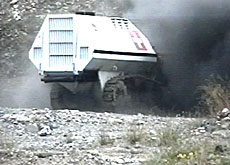Landmines: the indiscriminate killer

An anti-personnel mine is an explosive device designed to maim or kill the person who triggers it.
They target indiscriminately, killing and maiming soldiers and civilians alike even decades after fighting has ended.
In 1995, the United Nations estimated there were 120 million landmines worldwide.
Data collected by the International Committee of the Red Cross (ICRC) indicates that men aged 20 to 45 are most at risk, as they are more likely to be involved in outdoor activities such as farming.
The exception is in Afghanistan, where half of the victims are children under 18. Female victims represent between five and ten per cent of casualties, reaching a high of 20 per cent in Angola.
Five years ago, the International Mine Ban Treaty was signed in Ottawa, Canada, but the number of landmine victims continues to grow.
However, the Convention on the Prohibition of the Use, Stockpiling, Production and Transfer of Anti-Personnel Mines, which was signed by 130 states in 1997, has had a positive influence.
Some progress
The annual number of victims has fallen by more than 65 per cent in places such as Bosnia-Herzegovina, Cambodia and Croatia where there are programmes to clear and stop the use of landmines, as well as increasing public awareness.
Signatory countries to the Ottawa Treaty have reportedly destroyed 27 million of these mines. The number of countries producing the weapons dropped from 55 to 14 in the early 1990s.
Earlier this year, two of the world’s most mine-affected countries, Afghanistan and Angola, announced that they would sign the treaty. But 48 nations remain outside its remit.
There is compelling evidence that nine governments used anti-personnel mines between May 2001 and June 2002.
India and Pakistan have extensively mined the border between their two countries, and Russia is known to use mines in Chechnya.
Gulf War
The US military used anti-personnel mines during the Gulf War in 1991 and is said to have mines stored in Qatar, Kuwait, Saudi Arabia, Oman, Bahrain and elsewhere for possible use in Iraq.
Annually, there are up to 20,000 victims of landmines and unexploded ordinance (UXO).
Signatories to the Ottawa Treaty are facing two key deadlines: most states are required to complete the destruction of all stockpiled anti-personnel mines by March 2009; all mined areas on their territory on their territory should be cleared by the same year.
The ICRC is working with a number of governments to assist them in the ratification and implementation process for both the Ottawa Treaty and the 1980 Convention on Conventional weapons.
In 1995, the UN estimated there were 120 million landmines worldwide.
Annually, there are up to 20,000 victims of landmines and unexploded ordinance.
130 States have signed the Mine Ban Treaty, 48 remain outside it.
The US, Russia, China, India, Pakistan, Israel and Egypt refuse to sign.
It’s five years since the International Mine Ban Treaty was signed in Ottawa, Canada, but the number of landmine victims continues to grow.
Forty-eight nations remain outside the treaty, including the US, Russia, China, India, Pakistan, Israel and Egypt.
It has been reported that US is stockpiling mines in the Middle East for possible use in Iraq.

In compliance with the JTI standards
More: SWI swissinfo.ch certified by the Journalism Trust Initiative








You can find an overview of ongoing debates with our journalists here . Please join us!
If you want to start a conversation about a topic raised in this article or want to report factual errors, email us at english@swissinfo.ch.